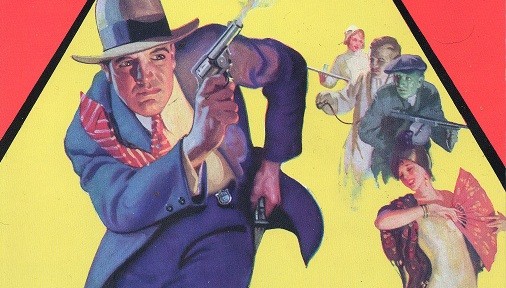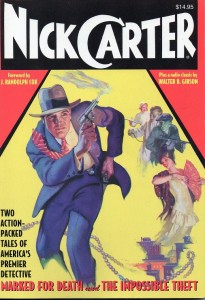Book Review: Nick Carter Volume 1
Nick Carter, master detective, is a character with a long history, in three distinct phases. He started in 1886 in stories most associated with the dime novels, was reinvented in 1933 for the pulps, and then again in 1964 as “Nick Carter Killmaster” for a long running series of action paperbacks. It’s the 1930s incarnation that this volume focuses on.
The house name for the writers of Nick Carter stories was Nick Carter; the first story in this volume, “Marked for Death” is by Richard Wormser. It’s Nick’s pulp magazine debut, and establishes Nick as a master of disguise and detection who isn’t afraid to use the three revolvers he carries. While more violence-prone than his Nineteenth Century incarnation, Nick is still more cerebral than hard-boiled.
Nick is called to Boston from his usual New York haunts by a friend whose father has been murdered and is now being hounded for money he supposedly owned. Problem is that last time he was in town, Nick Carter showed up the Boston police, and they are not going to be cooperative. Warning: Nick does not like Pomeranians, and casually kills one to test a theory.
“The Impossible Theft,” by Thomas C. McClary, is from 1934. It involves the theft of a quarter-million dollars from a bank in a manner which seems, frankly, impossible (and is never satisfactorily explained.) As a seeming side note, a cheap replica idol used to decorate the bank also vanishes. Nick Carter quickly connects this with the visit of a certain Maharajah to New York and infiltrates his Westchester mansion as a magician.
This story is much more fanciful than the first, and invokes the work of Charles Fort, as well as heavy doses of Orientalism and “the mysteries of the East.” People from South Asia are likely to find the depiction of the Maharajah and his court laughable, insulting or both, despite Nick’s new-found respect for some of their number.
The script for the first episode of “The Return of Nick Carter” radio series is also included. “The Strange Dr. Devolo” was written by Walter B. Gibson (scribe of the Shadow) and Edward Gruskin. The seemingly immortal mad scientist is using a weird crystal to hypnotize wealthy people into believing they’re famous people from the past. Nick has to track him down using secretary Patsy as a decoy and expose the strange doctor’s trickery.
The volume is rounded out by Nick Carter’s comic book incarnation from 1947, in “The Lucky Stiff” by Bruce Elliott and Bob Powell. Nick and Patsy go to the horse races, but the fix is in–in more ways than one! Despite the murder, this is a lighthearted tale that ends on a laugh.
There’s also several text pieces that introduce the various aspects of Nick Carter’s career.
Overall: While not up to the quality of the greats, these are some rip-roaring pulp tales. If you’re willing to put up with the period racism, you should be able to enjoy them as examples of one of American lowbrow literature’s enduring characters.


